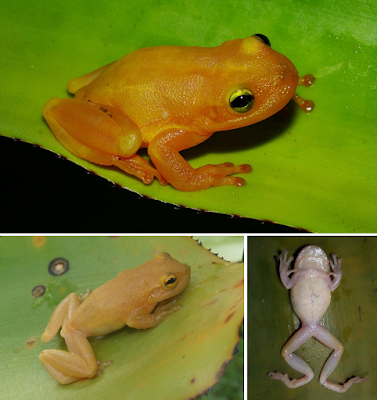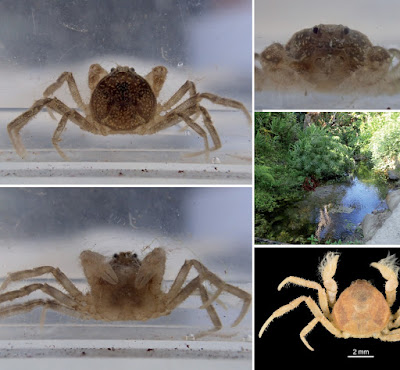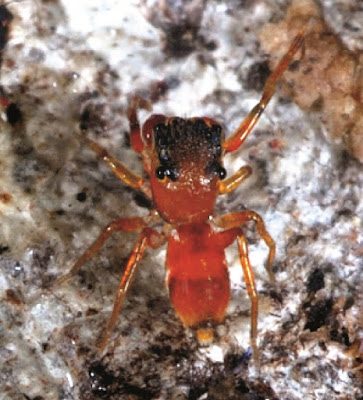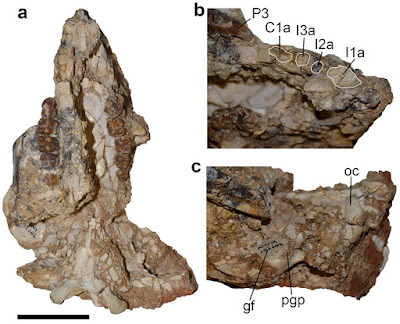[Most Recent Entries] [Calendar View]
Friday, June 26th, 2020
| Time | Event | ||||
| 6:42a | [Herpetology • 2020] Phyllodytes magnus • A New Large Canopy-dwelling Species of Phyllodytes Wagler, 1930 (Anura, Hylidae) from the Atlantic Forest of the State of Bahia, Northeastern Brazil
Abstract The known diversity of treefrogs of the genus Phyllodytes has rapidly increased in recent years, currently comprising 14 species. Recent field work in the Atlantic Rainforest of the state of Bahia lead to the discovery of a new large species of Phyllodytes which is herein described based on multiple evidence including morphological, acoustical and genetic data. Phyllodytes sp. nov. is one of the largest species within the genus and presents immaculate yellowish dorsum and limbs. The advertisement call of the species is composed of 7–31 notes (half pulsed/pulsatile-half harmonic) with frequency-modulated harmonics. Phyllodytes sp. nov. has a karyotype of 2n = 22 chromosomes, as also found in other species of the genus. Genetic distance values of the 16S mitochondrial rRNA among Phyllodytes sp. nov. and its congeners range between 6.4 to 10.2%. The description of another new species for this state reinforces the need for further taxonomic work with Phyllodytes in this region that has been revealed as a priority area for research and conservation of this genus. Phyllodytes magnus sp. nov. Phyllodytes kautskyi—(Freitas, 2015) Phyllodytes cf. kautskyi—(Freitas et al., 2018) Diagnosis. — A large species (SVL 36.4 to 41.1 mm in males, n = 3) characterized by (1) snout mucronate in dorsal view, acute in profile; (2) mandible with two anterior large odontoids on each side in adults; (3) adults males with dorsum of body and limbs immaculate, uniformly pale yellow; (4) dorsal skin granular; (5) ventral skin cream and evenly granular, lacking distinct rows of tubercles; (6) a row of tubercles along lateral surface of forearm and tarsus; (7) tubercle subarticular from second segment of finger IV single and rounded shape; (8) canthus rostralis immaculate; (9) tympanum size corresponding to 6.6–7.1% of SVL; (10) advertisement call consisting of a series of 7–31 composite notes (half pulsed/pulsatile–half harmonic). Etymology. — The specific epithet is an adjective from Latin meaning “great” or “large” (Lewis & Short, 1891), and refers to the large size of the adult males collected from this species, which are among the largest known in the genus. Geographic Distribution and Natural history. — Phyllodytes magnus is known from three localities from the Atlantic Rainforest of Bahia (Fig. S5). Calls of this species have also been heard in the municipalities of Almadina, Ilhéus, Igrapiúna and Camacan, state of Bahia, but as no vouchers or recordings were obtained, these records need to be confirmed. Although one specimen of Phyllodytes magnus was in a ground bromeliad, most calling males were in canopy bromeliads. At Parque Estadual da Serra do Conduru, Phyllodytes magnus is syntopic with four congeners (P. maculosus, P. megatympanum, P. melanomystax and P. praeceptor), although apparently less abundant than its relatives. In an area of 52 ha we heard only five males in a one-night search. All were calling from epiphytic giant bromeliads of the genus Hohenbergia with diameter superior to 1.50 m and at heights between 3.10 m and 11.30 m (x = 7.72 m ± 3.56 m). We found a male of Phyllodytes melanomystax in the same bromeliad where we collected the paratype MZUESC 18265, though in a different axil. Conclusions: Almost 60% (nine species) of the known diversity of Phyllodytes can be found in the Atlantic Forest of southern Bahia, the region with the highest concentration of representatives of this genus. Over half of these species are endemic to the state: P. wuchereri, P. praeceptor, P. megatympanum, P. amadoi and P. magnus, the latter three are known from a few localities or only from the type locality (Cruz, Marciano & Napoli, 2014; Marciano-Jr, Lantyer-Silva & Solé, 2017; Vörös, Dias & Solé, 2017; this study). The high diversity of Phyllodytes in this part of the central corridor of the Atlantic Forest (Carnaval et al., 2009) is not unique. Other genera like Adelophryne (Fouquet et al., 2012; Lourenço-de Moraes et al., 2018), Adenomera (Fouquet et al., 2014), Gastrotheca (Teixeira-Jr et al., 2012) or the gymnophthalmid lizard genus Leposoma (Rodrigues et al., 2013), to cite a few, have their highest species diversity in this part of the biome. The high diversity of Phyllodytes and endemism brings support to this pattern and highlights the evolutionary importance of this area. Furthermore, together with the scarce available biological information and habitat specificity (bromeliads), it makes the Atlantic Forest of the state of Bahia a priority area for research and conservation of Phyllodytes. Iuri R. Dias, Gabriel Novaes-e-Fagundes, Antonio Mollo Neto, Juliana Zina, Caroline Garcia, Renato Sousa Recoder, Francisco Dal Vechio, Miguel Trefaut Rodrigues and Mirco Solé. 2020. A New Large Canopy-dwelling Species of Phyllodytes Wagler, 1930 (Anura, Hylidae) from the Atlantic Forest of the State of Bahia, Northeastern Brazil. PeerJ. 8:e8642. DOI: 10.7717/peerj.8642 | ||||
| 7:05a | [Crustacea • 2020] Richerius marqueti • A New Freshwater Crab of the Family Hymenosomatidae MacLeay, 1838 (Decapoda, Brachyura) and An Updated Review of the Hymenosomatid Fauna of New Caledonia
Abstract A new genus and species, Richerius marqueti gen. et sp. nov., of a crab of the family Hymenosomatidae MacLeay, 1838 are described from the inland waters of New Caledonia based on several specimens collected in two streams at altitudes of 180 m and 500 m, respectively. Richerius marqueti gen. et sp. nov. was compared to the other freshwater species known in New Caledonia, Odiomaris pilosus (A. Milne-Edwards, 1873), and to species of Amarinus Lucas, 1980, a genus comprising many freshwater species in New Zealand, Australia, Indonesia, the Philippines, and Papua New Guinea, but never recorded in New Caledonia. The barcode fragment of the COI mitochondrial gene was sequenced for seven specimens of R. marqueti gen. et sp. nov., and all sequences were deposited in GenBank. A brief and updated review of the New Caledonian marine and freshwater hymenosmatid fauna is provided. Keywords: Richerius marqueti; new genus; new species; New Caledonia; COI Infraorder Brachyura Latreille, 1802 Subsection Heterotremata Guinot, 1977 Superfamily Hymenosomatoidea MacLeay, 1838 Family Hymenosomatidae MacLeay, 1838 Subfamily Odiomarinae Guinot, 2011 Genus Richerius gen. nov. Diagnosis: Carapace circular to oval, width only slightly exceeding length; dorsal carapace surface not strongly outlined by grooves; only gastrocardiac and thoracic grooves well defi ned, not reaching antero- and posterolateral margins; carapace rim continuous across behind rostrum. Rostrum broadly rounded, spade-shaped, slightly defl exed but not ending in narrow triangular tip extending between antennules. Proepistome represented by ventral expansion of rostrum (and not rostrum itself). Antennules obliquely folded along hollowed ventral parts of rostrum, entirely hidden dorsally. Antennae well separated from antennules, at least at their bases; urinary article at level of moderately developed epistome. Proepistome represented by ventral expansion of rostrum (and not rostrum itself). Lower orbital margin with one conspicuous knob, not visible dorsally. Mxp3 gaping at level of ischion/merus junction; merus and ischium broad, short, about subequal. .... Etymology:The genus name is in honour of Bertrand Richer de Forges for his lifetime commitment to carcinology, especially of New Caledonia, for having always been an excellent and untiring researcher, and for his friendship. Richerius marqueti gen. et sp. nov. Etymology:The species name is in honour of Gérard Marquet, who made extensive collections of freshwater crustaceans for more than 30 years in the Indo-Pacific islands and in particular in New Caledonia where he collected the new species here described, for his friendship and his constant enthusiasm in the field as well as in the laboratory. Danièle Guinot and Valentin de Mazancourt. 2020. A New Freshwater Crab of the Family Hymenosomatidae MacLeay, 1838 (Crustacea, Decapoda, Brachyura) and An Updated Review of the Hymenosomatid Fauna of New Caledonia. European Journal of Taxonomy. 671; 1-29. DOI: 10.5852/ejt.2020.671 | ||||
| 8:19a | [Arachnida • 2020] First Record of Synagelides Strand, 1906 (Araneae: Salticidae) from Sri Lanka: Description of Four Endemic Species from Tropical Wet Forest of the Island
Abstract Synagelides Strand, 1906 is recorded for the first time in Sri Lanka. Four new species are described and illustrated: S. hortonensis sp. nov., S. lakmalii sp. nov., S. rosalindae sp. nov. and S. orlandoi sp. nov. A key to the four new species is given. Keywords: Araneae, Arachnida, Biodiversity, ground spiders, leaf litter, threatened species
Nilani Kanesharatnam and Suresh P. Benjamin. 2020. First Record of Synagelides Strand, 1906 (Araneae: Salticidae) from Sri Lanka: Description of Four Endemic Species from Tropical Wet Forest of the Island. Zootaxa. 4790(1); 43–56. DOI: 10.11646/zootaxa.4790.1.2 The world’s a stage for these four new jumping spiders from Sri Lanka | ||||
| 8:57a | [PaleoMammalogy • 2020] Mukupirna nambensis • A New Family of Diprotodontian Marsupials from the latest Oligocene of Australia and the Evolution of Wombats, Koalas, and their Relatives (Vombatiformes)
Abstract We describe the partial cranium and skeleton of a new diprotodontian marsupial from the late Oligocene (~26–25 Ma) Namba Formation of South Australia. This is one of the oldest Australian marsupial fossils known from an associated skeleton and it reveals previously unsuspected morphological diversity within Vombatiformes, the clade that includes wombats (Vombatidae), koalas (Phascolarctidae) and several extinct families. Several aspects of the skull and teeth of the new taxon, which we refer to a new family, are intermediate between members of the fossil family Wynyardiidae and wombats. Its postcranial skeleton exhibits features associated with scratch-digging, but it is unlikely to have been a true burrower. Body mass estimates based on postcranial dimensions range between 143 and 171 kg, suggesting that it was ~5 times larger than living wombats. Phylogenetic analysis based on 79 craniodental and 20 postcranial characters places the new taxon as sister to vombatids, with which it forms the superfamily Vombatoidea as defined here. It suggests that the highly derived vombatids evolved from wynyardiid-like ancestors, and that scratch-digging adaptations evolved in vombatoids prior to the appearance of the ever-growing (hypselodont) molars that are a characteristic feature of all post-Miocene vombatids. Ancestral state reconstructions on our preferred phylogeny suggest that bunolophodont molars are plesiomorphic for vombatiforms, with full lophodonty (characteristic of diprotodontoids) evolving from a selenodont morphology that was retained by phascolarctids and ilariids, and wynyardiids and vombatoids retaining an intermediate selenolophodont condition. There appear to have been at least six independent acquisitions of very large (>100 kg) body size within Vombatiformes, several having already occurred by the late Oligocene. Systematic palaeontology Order Diprotodontia Owen, 1866 New Definition Suborder Vombatiformes Woodburne, 1984 New Definition Infraorder Vombatomorphia Aplin and Archer, 1987 New Definition Superfamily Vombatoidea Kirsch, 1968 New Definition Family Mukupirnidae Included taxa: Mukupirna nambensis new species Mukupirna nambensis gen. et. sp. nov. Differential diagnosis: differs from known members of Wynyardiidae in possessing a P3 that lacks a posterolingual cusp (=”hypocone”), less well-developed selenodonty, a less well-developed masseteric process, palatal vacuities entirely enclosed by the palatines, a proportionately longer deltopectoral crest and broader distal end of the humerus (Epicondylar index = 0.4422), a proportionately longer olecranon of the ulna (Index of Fossorial Ability = 0.4223), and a much larger body size (estimated body mass based on postcranial measurements = 143–171 kg); differs from vombatids in lacking bilobate molars (molars are only slightly bilobate in Nimbavombatus, Rhizophascolonus and Warendja, but strongly bilobate in other vombatids); differs from all vombatids except Nimbavombatus in retaining three upper incisors and the upper canine; differs from Nimbavombatus in larger size, more bicuspid P3, and palatal vacuities entirely enclosed by the palatines; differs from vombatids known from postcranial remains in lacking a laterally extensive deltopectoral crest of the humerus; differs from hypselodont vombatids in having closed premolar and molar roots; differs from known members of Thylacoleonidae in retaining only a single upper premolar (P3), with this tooth not as elongate or bladelike, lacking a marked reduction in molar size posteriorly, having a proportionately longer deltopectoral crest and broader distal end of the humerus, and having a proportionately longer olecranon of the ulna; differs from known members of Phascolarctidae in lacking strongly selenodont molars, having a less well-developed masseteric process, a proportionately longer deltopectoral crest and broader distal end of the humerus, and a proportionately longer olecranon of the ulna; differs from known members of Ilariidae in lacking posterobuccal and lingual cusps on P3, in lacking strongly selenodont molars, and in lacking a well-developed masseteric process; differs from known members of Diprotodontidae and Palorchestidae in lacking a molariform P3, molars not strongly bilophodont, in lacking a well-developed masseteric process, and in retaining palatal vacuities. Mukupirna nambensis cannot be compared directly with Marada arcanum (the only known representative of the vombatiform family Maradidae), because Mu. nambensis is only known from the cranium and upper dentition whereas Ma. arcanum is known only from the lower dentition, and it is possible that they represent the same taxon or are closely related (see the supplementary information). Holotype: AMNH FM 102646 (previously, QMAM 16824), a badly crushed cranium (preserved length = 197 mm; dorsal surface not preserved) with left and right P3-M4, and associated partial postcranial skeleton comprising vertebrae, ribs, left and right scapulae, left humerus, left ulna, left radius, left and right femora, left tibia, left fibula, and parts of the autopodia. The adult dentition is fully erupted, except possibly for M4, which does not appear to be in line with the occlusal surfaces of M1-3 (although this may be the result of post-mortem displacement); the molars are only lightly worn. In the postcranium, most fracturing has occurred at the epiphyseal plates. Collectively this suggests that this individual was probably a late subadult or young adult. Etymology: The generic name is from the words muku (“bones”) and pirna (“big”) in the Dieri (Diyari) language traditionally spoken in the area around Lake Eyre and refers to the large size of the animal. The species name nambensis is after the Namba Formation in which the only known specimen was found. Type Locality and Age: Lake Pinpa Site C, Namba Formation, Lake Frome area, South Australia. The Namba Formation has been correlated with the Etadunna Formation, which has been estimated to be 26-24 Ma old (i.e. latest Oligocene) on the basis of isotopic, foraminiferal, magnetostratigraphic and radiometric (Rb-Sr dating of illite) data. More recently, the Etadunna Formation has been proposed to be 26.1-23.6 Ma old based on a best-fit age-model of magnetostratigraphic data. The Pinpa Local Fauna is the oldest of the three distinct faunal units recovered from stratigraphic levels in the Namba Formation, and has been correlated with the oldest faunal zone (Zone A) of the Etadunna Formation, which has been dated as 25.3-24.9 Ma old (chrons 7An and 7Ar) based on magnetostratigraphy25. In summary, available evidence suggests a probable age of between approximately 26 and 25 MYA for the Pinpa Local Fauna. Robin M. D. Beck, Julien Louys, Philippa Brewer, Michael Archer, Karen H. Black and Richard H. Tedford. 2020. A New Family of Diprotodontian Marsupials from the latest Oligocene of Australia and the Evolution of Wombats, Koalas, and their Relatives (Vombatiformes). Scientific Reports. 10, 9741. DOI: 10.1038/s41598-020-66425-8 |
| << Previous Day |
2020/06/26 [Calendar] |
Next Day >> |



















